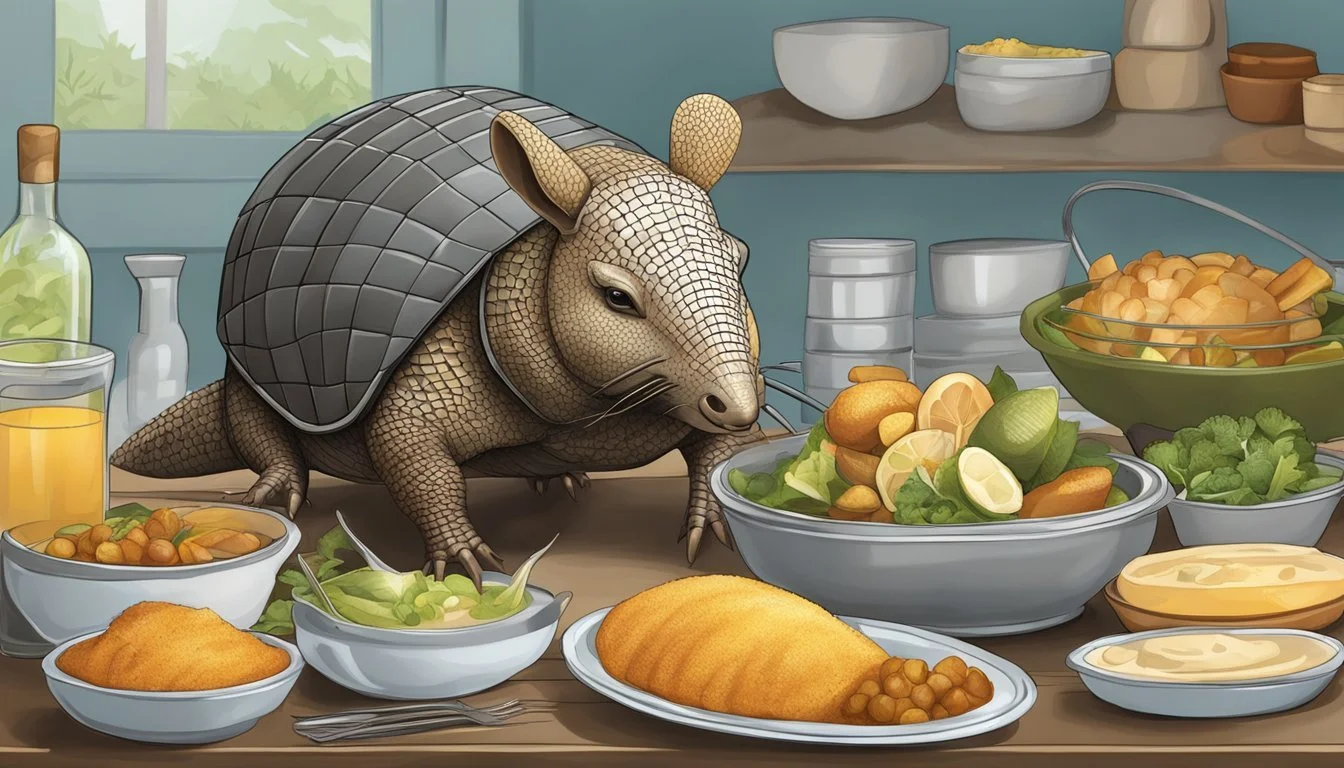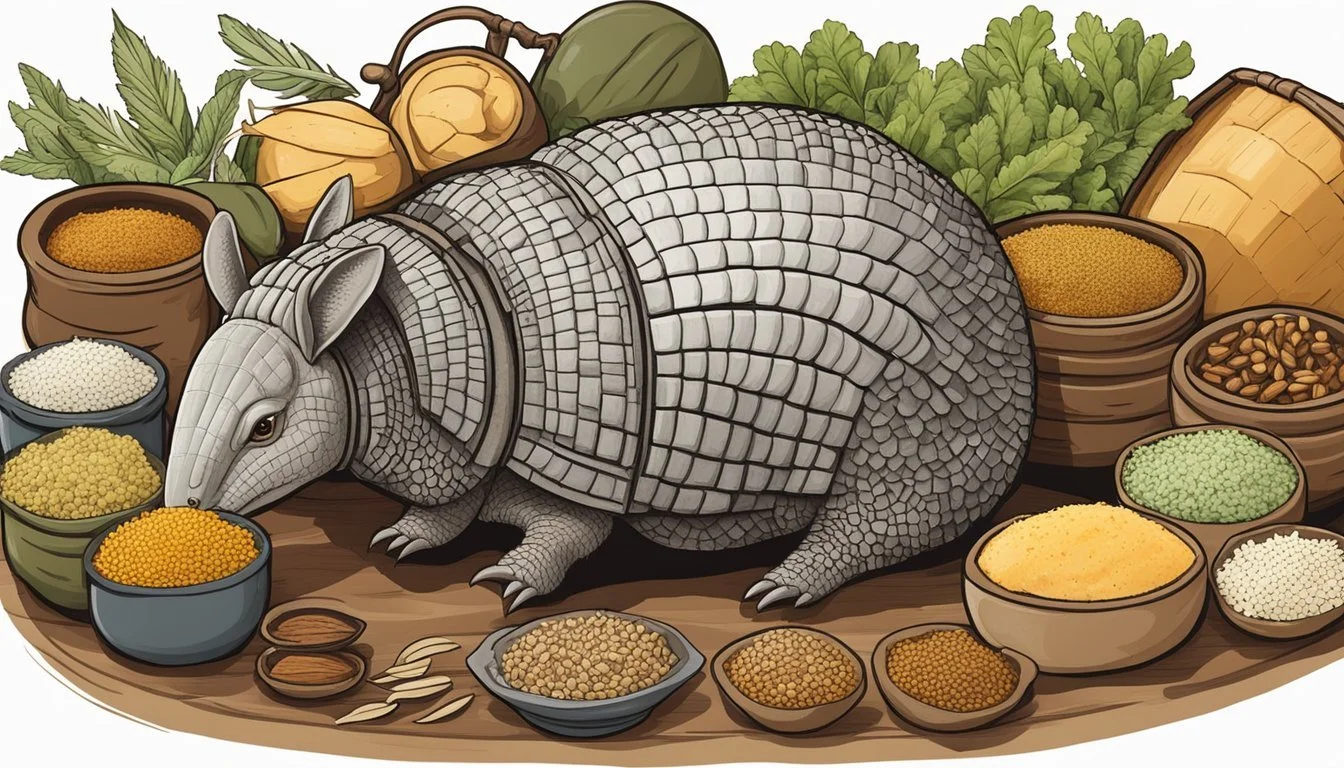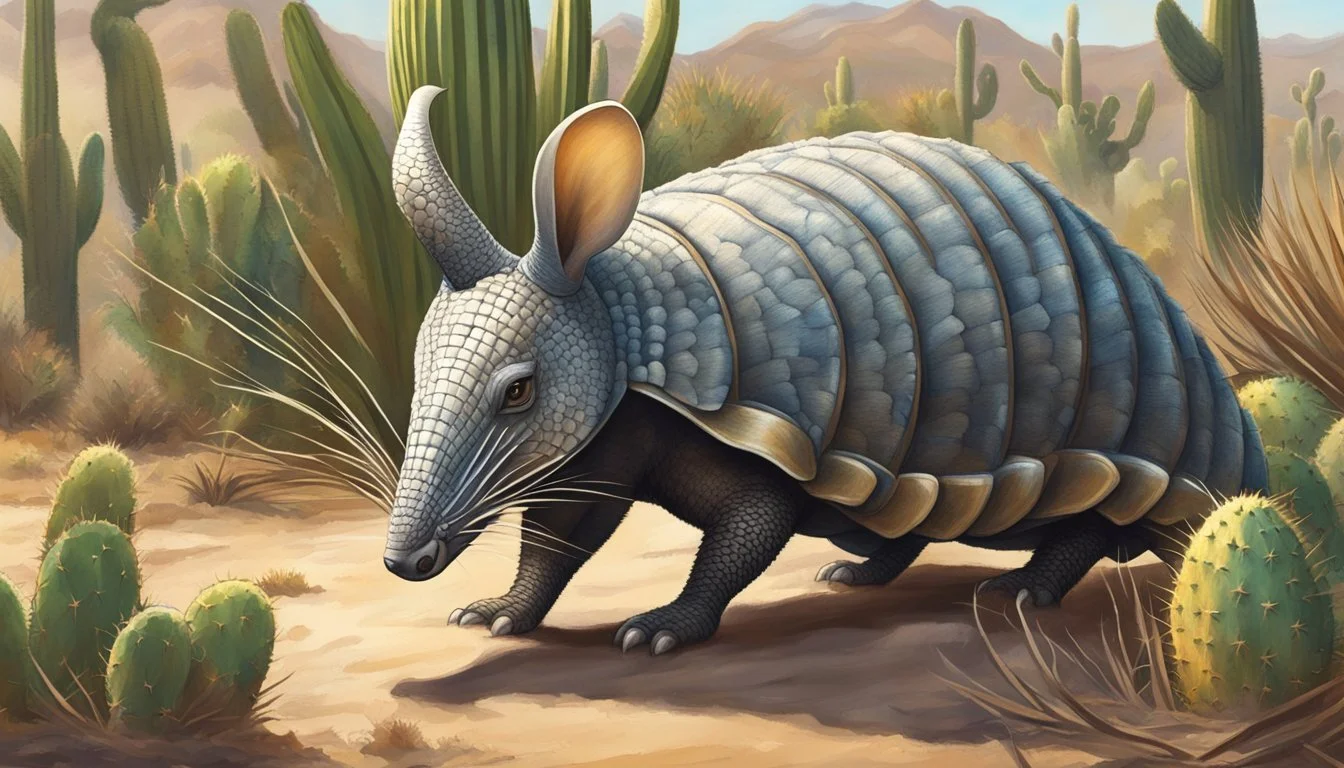Armadillo Cuisine
Exploring Texas' Controversial Bush Meat Delicacy
Armadillos, with their distinctive bony shells and nocturnal habits, have long been a part of Texas folklore and ecosystem. Originating from South America, these mammals forayed into Texan territory, with the nine-banded armadillo being first recorded in the state in 1849. Today, armadillos are a common sight across the Lone Star State, playing a complex role in its natural and cultural landscape.
The nine-banded armadillo's culinary use in Texas is a matter of both tradition and controversy. For some, armadillo meat, known locally as 'Texan bush meat', is a historical food source, reflecting a rugged, self-reliant way of life that echoes the state's frontier past. However, for others, the consumption of armadillos raises concerns, from ethical questions regarding wildlife consumption to health warnings due to the risk of disease transmission such as leprosy.
Despite differing views, the armadillo remains an intriguing subject in Texan culture. Its consumption as bush meat is a practice that underscores the diversity of regional cuisines within the state and sparks dialogue about wildlife management, conservation, and cultural heritage. As Texas continues to grapple with preserving its traditions while navigating modern ethical standards, the armadillo stands emblematic: an icon in the midst of evolving environmental and societal values.
Understanding Armadillos
Armadillos are a distinctive group of mammals known for their armored shells and burrowing habits, with a notable presence in the Texan ecosystem. This section explores the biology of these creatures and their role in Texas.
Biology and Species
Armadillos are part of the Dasypodidae family, with the nine-banded armadillo (Dasypus novemcinctus) being the most commonly recognized species in Texas. They possess a protective carapace composed of bony plates called bands, which can range in number from 7 to 11. These mammals are equipped with claws designed for digging, allowing them to create intricate burrows in various soil types.
Claws: Ideal for excavation, essential for shelter and foraging.
Bands: Provide a flexible armor, protecting against predators.
Burrows: Serve as a refuge, temperature regulator, and breeding ground.
Armadillos in the Texan Ecosystem
In Texas, armadillos play a pivotal role in the local ecosystem. They are native to the Americas, with a dense population stretching from Brazil to the southern United States. The nine-banded armadillo has become an emblematic species of Texas. It adapts well to a variety of habitats and is known for its ability to consume vast amounts of insects, contributing to the control of pests.
The armadillo's population in Texas is influenced by various factors:
Hunting: Although armadillos are sometimes hunted for food, known as bush meat, they aren't typically a primary food source for humans.
Leprosy Transmission: There is a very low risk, but possible, transmission of leprosy from armadillos to humans; however, with adequate precautions, the risk can be minimized.
Population Management: Natural predators, environmental changes, and human activity impact their numbers.
Armadillos are an integral part of Texas's biodiversity and possess unique biological characteristics that contribute to both their survival and the ecological balance.
History and Culture of Armadillo Consumption
Armadillo meat has a deep-rooted history in Texas and has evolved with immigrant influences, remaining a culinary curiosity and a staple for some.
Armadillo as Bush Meat in Texas
In Texas, the armadillo has long been considered a source of bush meat. Armadillo hunting became more prominent after the creature migrated from South America, eventually establishing itself in the ecological tapestry of Texas. The state's residents have used the meat for various purposes, including survival and population control. It has even found a place in Texas BBQ culture, although it is a niche ingredient compared to more mainstream meats.
Common Dishes:
Armadillo chili: A robust stew made with tender armadillo meat, infused with bold Texan spices.
Smoked armadillo: A delicacy occasionally featured in some adventurous Texas BBQ menus, often slow-cooked to enhance flavor.
Culinary Influence and Immigrant Traditions
The armadillo's culinary presence in Texas has been shaped by immigrant traditions as well, particularly those of Mexican and other Central American communities who brought their own methods of preparing and consuming armadillo. The meat is often enjoyed in traditional dishes that have been passed down through generations, creating a gastronomic fusion that characterizes New Texas cuisine. Cities like San Antonio serve as hubs where this culinary integration is most evident, showcasing armadillo dishes that reflect Texas' diverse cultural heritage.
Cultural Integration:
Cooking techniques from across the border have influenced how armadillo is prepared in Texan kitchens, including stews and roasts.
Festivals and family gatherings in places like Louisiana and Texas often feature armadillo as a testament to enduring regional customs.
Armadillo Dishes and Preparation Techniques
Armadillo meat has been integrated into various Texan dishes, characterized by its unique preparation and rich, gamey flavor. This section highlights traditional recipes, contemporary reinterpretations of classic dishes, and essential safety measures in cooking armadillo meat.
Traditional Texas Recipes
The preparation of traditional Texan armadillo usually involves marinating the meat for several hours, often with a blend of herbs and spices, to tenderize and infuse it with flavor. A typical recipe might include:
Marinating: 8 hours with turning
Cooking: Browning in butter, simmering in marinade for 1 to 1 1/4 hours
These dishes are sometimes complemented by ingredients like chili to enhance the robust taste of the protein.
Contemporary Armadillo Cuisine
Modern adaptations of armadillo recipes have emerged, giving rise to dishes like "Armadillo Eggs." Despite their name, these appetizers contain no actual armadillo or eggs. They’re made by:
Ingredients: Stuffing jalapeños with a mixture of cream cheese and cheddar cheese, sometimes incorporating sausage or bacon.
Preparation: The filled peppers are then wrapped in bacon and often smoked or grilled until the bacon is crisp.
Serving: Accompanied by salsa or other dips.
This contemporary take on Texan cuisine reflects the versatility and creativity of regional flavors.
Safety and Cooking Precautions
When preparing and cooking armadillo meat, safety is paramount due to health risks such as the transmission of leprosy. The following precautions are advised:
Marinating: Use ingredients like buttermilk to marinate and tenderize the meat.
Handling: Ensure all meat is thoroughly cooked to the appropriate internal temperature to eliminate risks.
Hygiene: Maintain proper sanitation of cooking surfaces and utensils, and wash hands after handling uncooked meat.
Cooking techniques such as smoking or barbecuing not only add flavor but also help in thoroughly cooking the meat, which is critical for safety.
Modern Adaptations and Fusion Cuisine
In recent years, the versatile armadillo has found its way into the realms of modern Tex-Mex dishes and global cuisine, inspiring daring new dishes that are as innovative as they are controversial.
Armadillo-Inspired Tex-Mex Foods
Armadillo is not typically a mainstream menu item, but inventive chefs in Texas have begun infusing traditional Tex-Mex foods with armadillo meat. Two noteworthy innovations include Armadillo Jalapeño Poppers, where the meat is minced and mixed with cream cheese, stuffed into jalapeños, and grilled to perfection. They have also created Armadillo Smoked Sausage, a spicy and smoky addition perfect for enhancing the robust flavors of a traditional Texas BBQ sauce.
Grilled Armadillo: Often seasoned and grilled, serving as a protein-rich addition to Tex-Mex classics.
Armadillo Enchiladas: Slow-cooked armadillo meat, rolled into masa tortillas, topped with salsa or cheese, and baked.
Global Influences and New Trends
The use of armadillo meat isn't just confined to Tex-Mex cuisine; global fusion dishes have also emerged. In an intricate blend of traditions, armadillo is being experimented with in various forms, creating a niche in international markets susceptible to exotic tastes. An example is the innovative Armadillo Breakfast Burrito, where smoked armadillo sausage is combined with eggs, cheese, and vegetables, offering a unique twist to the global favorite, the breakfast burrito.
Armadillo Fusion Grill: Combining armadillo with global ingredients to create unexpected yet harmonious dishes.
Armadillo International: Chefs outside of Texas experiment with armadillo meat, blending it into their respective nation's culinary lexicon.
Etiquette and Debates
The consumption of armadillo meat is surrounded by ethical debates and health concerns. Both the etiquette of eating this controversial cuisine and the associated risks merit close examination.
Ethical Considerations in Consuming Armadillo
Conservation: There are ethical implications surrounding armadillo consumption, primarily due to conservation concerns. The population status of armadillos varies by region, with some areas experiencing overpopulation and others seeing declines. It's important to consider the impact that hunting and consumption may have on local ecosystems.
Debates: In regions where armadillos are not overpopulated, debates arise about the sustainability of consuming this wildlife species. The concern is whether hunting for cuisine purposes can lead to population decline and if there should be restrictions to balance ecological integrity with cultural customs.
Health Risks and Public Concerns
Leprosy: A notable health risk associated with consuming armadillo is the possible transmission of leprosy to humans. The bacteria Mycobacterium leprae, which causes leprosy, has been found in some armadillo populations, leading to safety warnings about consuming the meat.
Health Risks: Beyond leprosy, there are also general health risks tied to the proper handling and cooking of armadillo meat. Safety protocols must be strictly followed to avoid foodborne illnesses, often making armadillo a more controversial cuisine choice.
Public Concerns: These health concerns also lead to public debates about whether armadillo should be consumed at all. The safety is not just an individual concern; it impacts public health systems and community well-being.
Armadillo as a Protein Source
The armadillo, a unique mammal found primarily in the Americas, is not just a subject of biological curiosity but also a source of protein. In Texas, where the armadillo is most prominently recognized, it is sometimes regarded as "bush meat."
Nutritional Value: Armadillo meat is composed of high-quality protein that is comparable to more traditional meats like beef or pork. A review of armadillo-derived dishes reveals the meat is lean with low levels of saturated fat, making it a potentially healthier alternative.
Preparation Methods: Armadillo meat can be prepared in various ways:
Roasted
Stewed
Grilled
In culinary circles, chefs may advocate for the meat's versatility and nuanced flavor, which is often described as a cross between pork and venison (What wine goes well with venison?).
Hunting Practices: Hunting armadillos can be a sensitive topic. Methods often involve tracking them to their burrows or capturing them during their nocturnal foraging. Still, maintaining a balanced ecosystem requires responsible hunting practices, and the armadillo's role should not be underestimated.
Comparison Protein (g) Fat (g) Calories Armadillo 30 4 150 Beef 27 15 250 Pork 25 20 270
Considerations: Armadillos are also carriers of the bacterium that causes leprosy, which raises public health concerns regarding their consumption. Proper cooking of the meat is essential to eliminate the risk of transmission. Therefore, while armadillo meat offers nutritional benefits as a protein source, it is crucial for consumers to be informed and cautious.
Culinary Techniques and Pairings
Armadillo meat, a somewhat exotic ingredient outside mainstream Texan cuisine, can be prepared using various methods that highlight its unique flavor. When cooked thoughtfully, armadillo can be paired with a range of flavors and ingredients that complement its distinct taste.
Grilling and Smoking Armadillo
Grilling or smoking armadillo properly requires a low and slow approach to preserve its tenderness. Preparing the meat with a dry rub featuring traditional Texas BBQ spices before grilling over wood chips can infuse it with a smoky flavor. Using a smoker to cook the meat at a consistent temperature ensures the armadillo remains moist and succulent.
Typical Cooking Temperatures: 225-250°F (107-121°C)
Estimated Cooking Time: 4-6 hours
Using a BBQ sauce as a mop or baste can add an additional dimension of sweetness and tang to the dish. A light brushing during the last hour of cooking will prevent burning and create a desirable glaze.
Accent Flavors and Accompaniments
Armadillo meat, with its bold and gamey profile, pairs well with bold cheeses and spicy elements. Incorporating cheddar and jalapeño into side dishes or as toppings can complement and cut through the richness of the meat.
Bacon-wrapped armadillo is another popular preparation, where the smokiness of bacon enriches the overall flavor profile.
For a creamy contrast, a filling or topping of cream cheese can be added. Here's a simple accompaniments list:
Cheddar cheese, shredded or melted
Jalapeño, sliced or diced for heat
Bacon, wrapped around pieces of armadillo
Cream cheese, as a filling or dollop
Ketchup, homemade or artisanal, for dipping
Beer, local craft brews are recommended, to serve alongside
Roasted or grilled vegetables (What wine goes well with grilled vegetables?) also make a great side, providing balance with their earthy and charred notes. The ideal pairing is a matter of personal preference, but typically, bold flavors are sought to match the armadillo’s uniqueness.
Armadillo in Outdoor Activities
In Texas, the armadillo's presence influences various outdoor activities, with hunting at the forefront. Despite the controversy, some view armadillo hunting as a traditional practice. Armadillos are often targeted for their meat, referred to as "Texan bush meat." Hunters typically use rifles or shotguns, although it's worth noting that the armadillo's tough armor can occasionally deflect bullets, which poses safety concerns.
Fishing enthusiasts may sometimes encounter armadillos near water bodies, as these creatures are skilled swimmers. However, fishing activities in Texas are generally not directly affected by armadillos, given their different ecological niches.
When it comes to cooking outdoors, grilled armadillo is considered a specialty by some, despite the health risks involved. It is critical to highlight that armadillos can carry leprosy, and one must exercise caution when handling or preparing the meat. Here are recommended safety steps for those who choose to grill armadillo meat:
Ensure thorough cooking to eliminate potential pathogens.
Wear protective gloves when handling raw meat.
Avoid consumption if any signs of the disease are present in the meat.
Outdoor activities like camping and hiking can also see interactions with armadillos, as they are nocturnal creatures and may rummage through campsites. It's important to secure food sources to discourage armadillo and other wildlife disturbances.
Although not as popular as other game, the armadillo has carved a niche in Texan outdoor culture, with a clear stance needed on both conservation and public health to guide responsible interaction with these unique creatures.
Conclusion
Armadillos, known for their distinctive armor-like shell, have established a deep-rooted presence in Texan culture. The consumption of armadillo meat is an enduring practice that has persisted through generations. Regarded by some as a unique component of regional cuisine, armadillos offer a taste that is both intriguing and traditional.
The culinary use of armadillo meat remains a debated topic, due to concerns over sustainability and health. Leptospirosis and the bacteria that cause leprosy, both associated with armadillos, prompt caution. Food safety regulations and proper cooking methods are essential to mitigate these risks.
Cultural Significance:
Armadillos hold a symbolic place in Texan heritage.
Cuisine reflects historical and socioeconomic factors.
Future Trends:
Shifts in public opinion on exotic meats.
Conservation and animal welfare considerations.
Potential for armadillo-inspired alternatives.
Given the growing emphasis on conservation, Texans may see a decline in armadillo consumption. Conversations around traditional practices, animal rights, and environmental impact influence dietary choices. Chefs and food enthusiasts might explore alternative ingredients that capture the essence of armadillo without compromising animal populations.
The armadillo's role in Texas evokes pride and fascination. Whether celebrated or contested, the armadillo as bush meat is a testament to the richness and complexity of Texan culinary and cultural landscapes. As tastes and values evolve, so too will the narratives surrounding this enigmatic creature.










